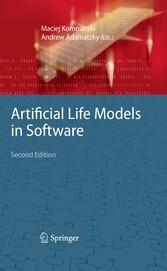Suchen und Finden
Preface
5
Contents
8
List of Contributors
17
Part I Virtual Environments
20
Chapter 1 Avida: A Software Platform for Research in Computational Evolutionary Biology
21
1.1 Introduction to Avida
21
1.2 The Scientific Motivation for Avida
25
1.3 The Avida Software
26
1.4 A Summary of Avida Research
45
1.5 Outlook
49
References
50
Chapter 2 Foundations of and Recent Advances in Artificial Life Modeling with Repast 3 and Repast Simphony
54
2.1 Introduction
54
2.2 REPAST
57
2.3 Repast Artificial Life Models
70
2.4 Conclusions
74
References
75
Chapter 3 Sodarace: Continuing Adventures in Artificial Life
78
3.1 The Sodarace Project
78
3.2 Introduction
79
3.3 Sodarace, the Scientific Background
81
3.4 Software for Artificial Life in Sodarace
84
3.5 Lessons Learned on Approaches for Artificial Life in Sodarace
84
3.6 Interactions in Sodarace: The Evolution of the Forums
88
3.7 Experiments with Sodarace
91
3.8 Summary: The Future of Sodarace
93
References
94
Chapter 4 3D Multi-Agent Simulations in the breve Simulation Environment
95
4.1 Overview
95
4.2 Motivations
100
4.3 Writing Simulations in breve
102
4.4 Breve Features and Technical Details
107
4.5 Development History and Future Developmen
111
4.6 ALife/AI Research with breve
112
4.7 Educational Applications of breve
116
4.8 Conclusion
120
References
120
Chapter 5 Framsticks: Creating and Understanding Complexity of Life
123
5.1 Available Software and Tools
124
5.2 Simulation
127
5.3 Genetics and Evolution
136
5.4 Scripting
139
5.5 Advanced Features for Research and Education
145
5.6 Research and Experiments
150
5.7 Education with Entertainment
160
5.8 Summary
162
References
163
Part II Lattice Worlds
165
Chapter 6 StarLogo TNG: Making Agent-Based Modeling Accessible and Appealing to Novices
166
6.1 Computational Modeling
166
6.2 Original Design Criteria
170
6.3 StarLogo
171
6.4 StarLogo: The Next Generation
172
6.5 The StarLogo TNG Virtual Machine
179
6.6 StarLogo TNG Example Model
183
6.7 Field Testing
190
6.8 Conclusion
195
References
196
Chapter 7 From Artificial Life to In Silico Medicine: NetLogo as a Means of Translational Knowledge Representation in Biomedical Research
198
7.1 Introduction
198
7.2 Facilitating Dynamic Knowledge Representation: The NetLogo Toolkit
205
7.3 NetLogo Models of Acute Inflammation
209
7.4 Conclusion
223
References
224
Chapter 8 Discrete Dynamics Lab: Tools for Investigating Cellular Automata and Discrete Dynamical Networks
230
8.1 Introduction
230
8.2 DDLab’s Interface and Initial Choices
241
8.3 Network Parameters
245
8.4 Network Architecture
254
8.5 Running Space-Time Patterns and Attractor Basins
256
8.6 Measures and Data
263
8.7 Reverse Algorithms
269
8.8 Chain-Rules and Dynamical Encryption
270
8.9 DDLab Website, Manual, and Reviews
272
References
272
Chapter 9 EINSTein: A Multiagent-Based Model of Combat
274
9.1 Background
274
9.2 Land Combat as a Complex Adaptive System
276
9.3 Agent-Based Modeling and Simulation
277
9.4 EINSTein
278
9.5 Combat Engine
283
9.6 Sample Patterns and Behavior
288
9.7 Genetic Algorithm Breeding
304
9.8 Discussion
313
9.9 Overview of Features in Newer Versions
320
9.10 Next Step
326
References
327
Part III Artificial Chemistries
331
Chapter 10 From Artificial Chemistries to Systems Biology: Software for Chemical Organization Theory
332
10.1 Introduction
332
10.2 Using Tools from Systems Biology: SBML and SBW
335
10.3 Chemical Organization Theory
337
10.4 Software for the Computation of Chemical Organizations
346
10.5 Conclusion
353
References
354
Chapter 11 Spatially Resolved Artificial Chemistry
356
11.1 Introduction
356
11.2 Concepts
358
11.3 Available Software and Tools
371
11.4 Conclusion
377
References
378
Part IV Artificial Life Arts
381
Chapter 12 Simulated Breeding: A Framework of Breeding Artifacts on the Computer
382
12.1 Introduction
382
12.2 Basic Framework of IEC
384
12.3 SBART and SBEAT
385
12.4 Breeding in a Field Window
389
12.5 Multifield User Interface
390
12.6 Partial Breeding
393
12.7 Direct Genome Operation
396
12.8 Production Samples
397
12.9 Future Works
401
12.10 Conclusion
402
References
402
Chapter 13 The Evolution of Sonic Ecosystems
404
13.1 Introduction
404
13.2 Eden: An Artificial Life Artwork
406
13.3 Agents and Environments
409
13.4 Interaction
418
13.5 Results
421
13.6 Conclusion
423
References
423
Chapter 14 Enriching Aesthetics with Artificial Life
426
14.1 Introduction
426
14.2 Wonder and the Sublime in Art and Nature
427
14.3 Sublime Software
430
14.4 The Betrayal of Points and Lines
432
14.5 Moving Beyond Two Dimensions
433
14.6 Spaces That Build Themselves
435
14.7 An Ecosystemic Approach to Writing Artistic Software
437
14.8 Conclusion
440
References
441
Appendix: Artificial Life Software
443
Index
448
Alle Preise verstehen sich inklusive der gesetzlichen MwSt.








